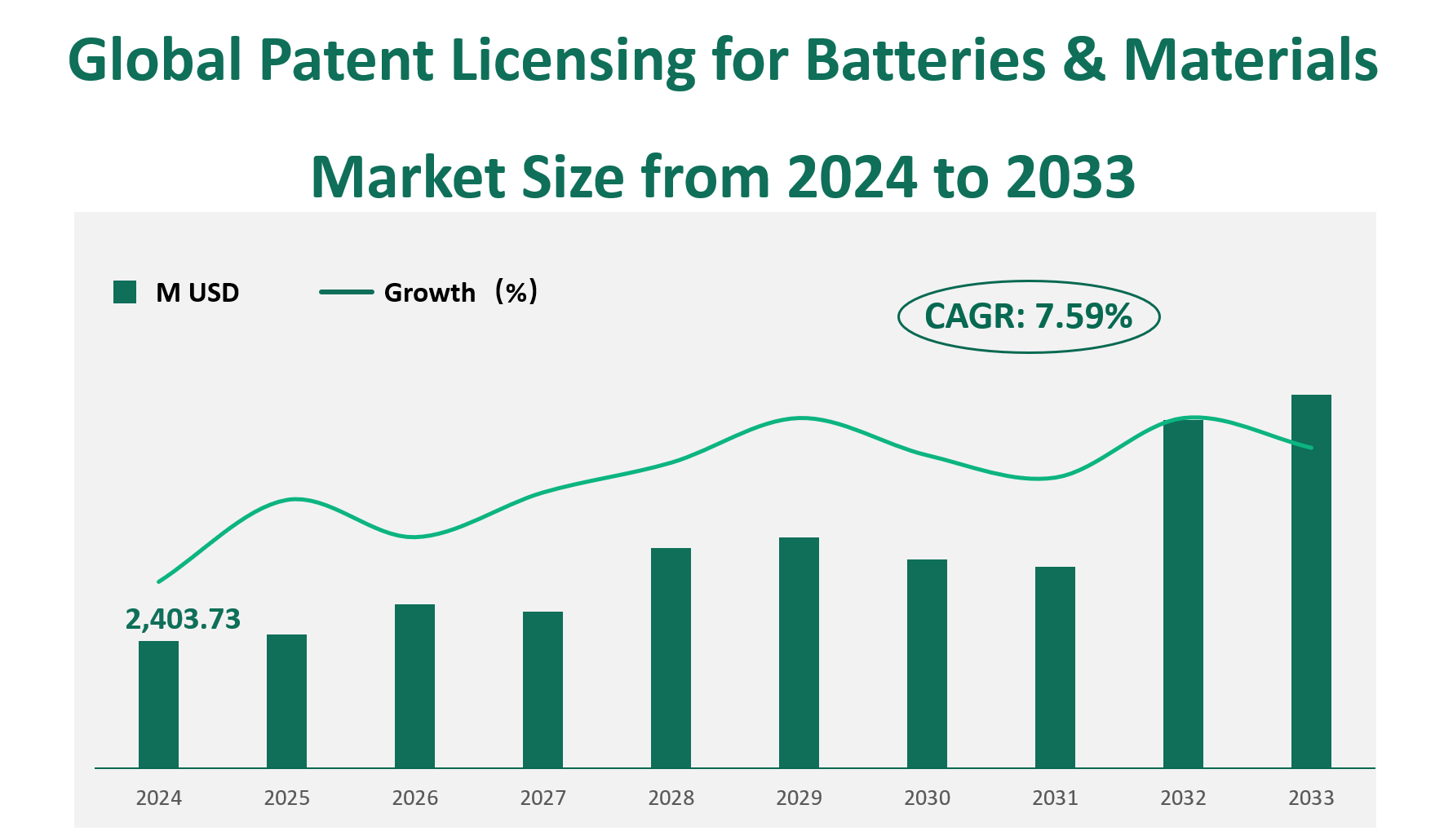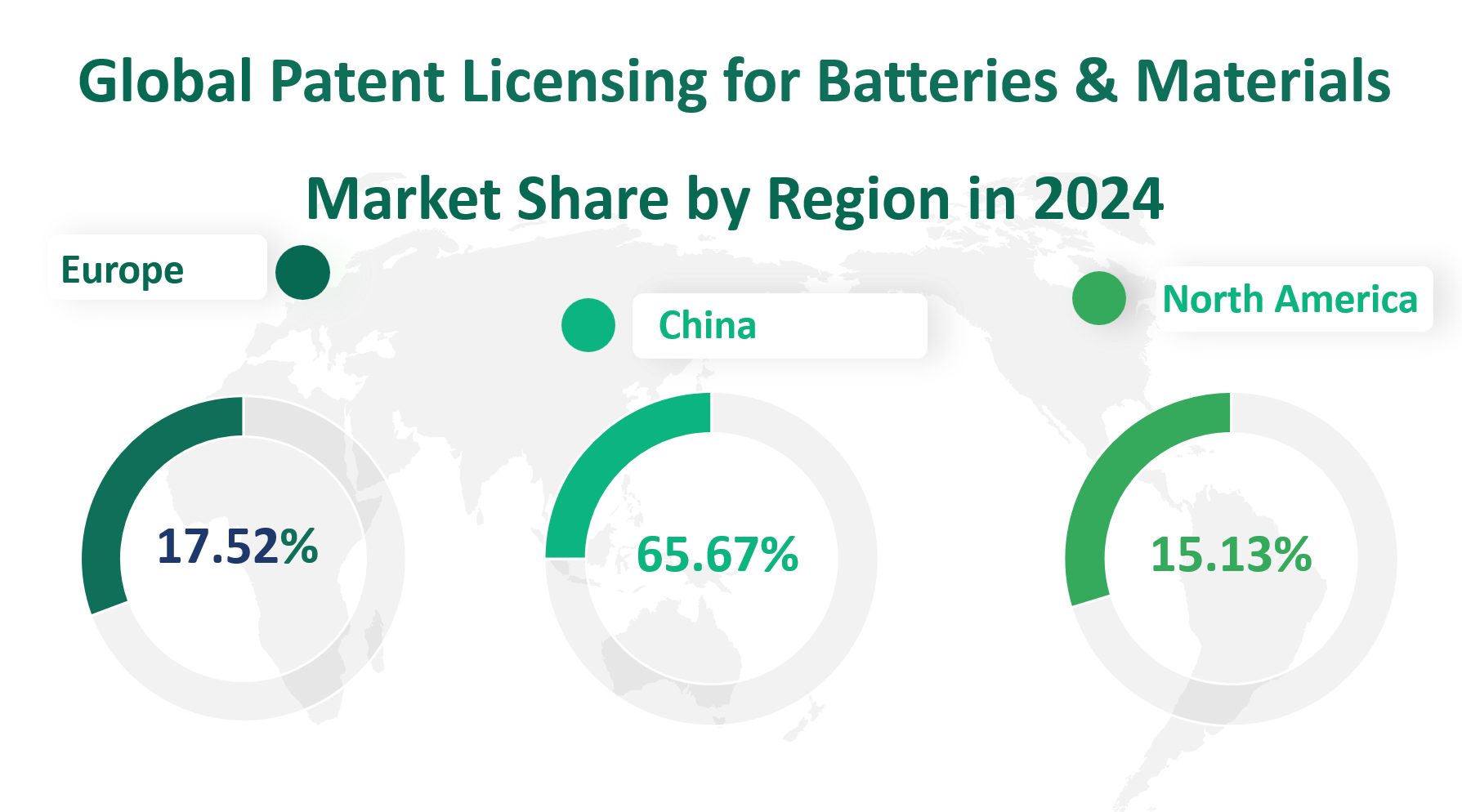1. Global Patent Licensing for Batteries & Materials Market Insight Analysis
In 2024, the global Patent Licensing for Batteries & Materials market value is estimated to reach 2,403.73 million USD, with a a Compound Annual Growth Rate (CAGR) of 7.59% from 2024 to 2033. This market encompasses a wide range of activities related to the licensing of intellectual property rights associated with battery manufacturing technologies, battery material formulations, and the production processes involved. The market is segmented by type into exclusive and non-exclusive licenses, with the former offering exclusive rights to a licensee, while the latter allows multiple licensees to utilize the same technology.
Patent licensing in this context is a strategic tool that allows companies to capitalize on their intellectual property by granting others the right to use their patented technologies. This not only generates revenue through licensing fees but also fosters innovation and technological diffusion across the industry. The market’s growth is also influenced by the increasing complexity of battery technologies, particularly in the development of solid-state batteries, which offer higher energy density, improved safety, and reduced weight compared to traditional lithium-ion batteries. These advancements are expected to drive further demand for patent licensing in the coming years.
Figure Global Patent Licensing for Batteries & Materials Market Size (M USD) and CAGR (2024-2033)

2. Driving and Limiting Factors of Patent Licensing for Batteries & Materials Market Growth
The growth of the Patent Licensing for Batteries & Materials market is influenced by several key drivers and limiting factors. On the positive side, the rapid development of new energy vehicles and consumer electronics industries is a significant driver. The increasing demand for high-performance batteries to power electric vehicles and consumer devices has led to a surge in the need for advanced battery technologies and materials. This trend is further supported by government policies aimed at promoting the adoption of electric vehicles and renewable energy sources, which in turn boosts the demand for battery technologies.
Another key driver is the global push towards carbon neutrality. Governments around the world are implementing policies to reduce carbon emissions, which has led to increased investment in battery technologies for energy storage and electric vehicles. This trend is particularly evident in regions such as Europe and Asia-Pacific, where countries like Norway, the UK, and China have set ambitious targets for phasing out fossil fuel vehicles and increasing the share of renewable energy in their power grids.
However, the market also faces several limiting factors. One of the primary challenges is the short battery technology upgrade cycle, which requires continuous innovation and investment in research and development. The development of solid-state batteries, for instance, is still in its nascent stages, and companies face significant technical hurdles in scaling up production and achieving commercial viability. Additionally, the market is highly competitive, with numerous players vying for a share of the lucrative licensing opportunities. This competition can lead to increased costs for licensees and potential conflicts over intellectual property rights.
Another limiting factor is the potential for market saturation in certain regions. As more companies enter the market and existing players expand their portfolios, the availability of unique and valuable patents may become limited, leading to increased competition and potentially lower licensing revenues. Furthermore, the market is also subject to regulatory and legal challenges, including patent disputes and intellectual property litigation, which can hinder the smooth functioning of the licensing ecosystem.
3. Technology Innovation and Corporate Mergers and Acquisitions in Patent Licensing for Batteries & Materials Market
The Patent Licensing for Batteries & Materials market is characterized by continuous technological innovation and strategic corporate activities such as mergers and acquisitions. Companies are investing heavily in research and development to stay ahead in the highly competitive landscape. For instance, advancements in solid-state battery technology are a key area of focus, with companies like Samsung, Panasonic, and Toyota leading the way in developing next-generation batteries that offer significant improvements in energy density, safety, and longevity.
Corporate mergers and acquisitions are also playing a crucial role in shaping the market. These strategic moves allow companies to expand their technology portfolios, gain access to new markets, and strengthen their competitive positions. For example, BASF and Umicore entered into a non-exclusive patent cross-license agreement in 2021, covering a broad range of cathode active materials and their precursors. This partnership aims to enhance the development and commercialization of advanced battery materials, thereby driving innovation and market growth.
Another notable example is the acquisition of Johnson Matthey’s battery materials business by EV Metals Group (EVM) in 2022. This transaction positions EVM as a key supplier of high-purity chemicals and cathode active materials to the growing electric vehicle market, highlighting the strategic importance of securing critical battery materials in the industry.
In addition to these strategic moves, companies are also engaging in collaborative efforts to accelerate the development and deployment of new technologies. For instance, LG Energy Solution obtained a license from CAMX Power for its GEMX® advanced cathode material platform, which is expected to enhance the performance and cost-effectiveness of lithium-ion batteries for electric vehicles. These collaborative efforts and strategic alliances are essential for driving innovation and ensuring the successful commercialization of advanced battery technologies.
4. Global Patent Licensing for Batteries & Materials Market Size by Type
Patent licensing for batteries and materials involves granting rights to use intellectual property related to battery manufacturing technology, battery material formulation, and the production processes of these materials. The market is segmented into two primary types: Exclusive License and Non-Exclusive License.
Exclusive License grants the licensee sole rights to exploit the intellectual property within a defined territory. The licensor is excluded from using the IP in the licensed area, ensuring the licensee has a monopoly. This arrangement typically results in higher costs and higher royalty payments for the licensor.
Under a non-exclusive license, the licensor retains the right to use the IP and can grant multiple licensees the right to exploit the same technology. This type is more flexible and allows for broader market penetration but generally commands lower royalty rates.
The market size for exclusive licenses is forecasted to be around $974.31 million USD, while non-exclusive licenses are expected to reach $1429.43 million USD.
Table Global Patent Licensing for Batteries & Materials Market Size by Type in 2024
5. Global Patent Licensing for Batteries & Materials Market Size by Application
The applications of patent licensing for batteries and materials are primarily categorized into two segments: Batteries and Materials.
Batteries application involves licensing patents related to the entire battery production process, including solid-state batteries, lithium-ion batteries, and other advanced battery technologies. These patents cover innovations in battery design, energy density improvements, safety enhancements, and manufacturing processes.
Materials application focuses on licensing patents related to battery materials, such as positive and negative electrode materials, electrolytes, and other components. These patents are crucial for improving the performance, durability, and cost-effectiveness of battery materials.
The market size for batteries is expected to reach $1663.97 million USD, while the market size for materials is forecasted to be $739.76 million USD.
Table Global Patent Licensing for Batteries & Materials Market Size by Application in 2024
|
Application |
Market Size (M USD) 2024 |
|
Batteries |
1663.97 |
|
Materials |
739.76 |
6. Global Patent Licensing for Batteries & Materials Market by Top Regions
The Asia-Pacific region is the largest market for Patent Licensing for Batteries & Materials, with a market size of 1,578.56 million USD in 2024. This region’s dominance is attributed to its robust industrial base. The rapid growth of the electric vehicle (EV) market and the increasing demand for renewable energy storage solutions have further bolstered the market in this region. China, in particular, has emerged as a global leader in battery manufacturing, with companies like CATL and BYD driving innovation and production capacity. Japan and South Korea are also key players, with Panasonic, LG, and Samsung contributing significantly to the development of advanced battery technologies.
Europe is another significant market, with a projected size of 421.12 million USD in 2024. The region’s market growth is driven by stringent environmental regulations and ambitious targets for carbon neutrality. Governments across Europe are promoting the adoption of electric vehicles and renewable energy, which has led to increased demand for high-performance batteries. Germany, France, and the UK are key markets within Europe, with companies like Bosch and BMW actively involved in battery technology development. The European market is also characterized by a strong focus on sustainability and innovation, with many companies investing in research and development to improve battery efficiency and reduce environmental impact.
North America, with a market size of 363.61 million USD in 2024, is another important region for the Patent Licensing for Batteries & Materials market. The United States and Canada are the primary markets, with the US leading in terms of technological innovation and investment. The growth in North America is driven by the increasing demand for electric vehicles and the need for advanced battery technologies to support the transition to renewable energy. Companies like Tesla and General Motors are at the forefront of this trend, driving the development of next-generation batteries. Additionally, the region benefits from strong research and development capabilities, with universities and research institutions playing a crucial role in advancing battery technology.
Figure Global Patent Licensing for Batteries & Materials Market by Region in 2024

7. Global Patent Licensing for Batteries & Materials Market Analysis by Major Players
7.1 Samsung
Introduction and Business Overview: Samsung is a South Korean multinational conglomerate with a diverse portfolio of businesses, including consumer electronics, semiconductors, and telecommunications. The company is a leader in battery technology and has a strong presence in the global market. Samsung’s business is characterized by its focus on innovation and technological advancement, with significant investments in research and development.
Products Offered: Samsung offers a wide range of products, including lithium-ion batteries, solid-state batteries, and advanced battery materials. The company is also involved in the development of next-generation battery technologies, such as solid-state batteries, which offer higher energy density and improved safety.
Sales Revenue in 2022: Samsung’s revenue from the Patent Licensing for Batteries & Materials business was $275.41 million USD in 2022.
7.2 Panasonic Corp.
Introduction and Business Overview: Panasonic is a Japanese multinational electronics company with a long history of innovation and technological excellence. The company is a major player in the battery industry, particularly in the development and production of lithium-ion batteries. Panasonic’s business is characterized by its focus on sustainability and environmental responsibility, with significant investments in renewable energy and energy storage solutions.
Products Offered: Panasonic offers a wide range of battery products, including lithium-ion batteries for consumer electronics, electric vehicles, and energy storage systems. The company is also involved in the development of advanced battery materials and technologies, such as solid-state batteries and high-capacity lithium-ion cells.
Sales Revenue in 2022: Panasonic’s revenue from the Patent Licensing for Batteries & Materials business was $208.53 million USD in 2022.
7.3 LG
Introduction and Business Overview: LG is a South Korean multinational conglomerate with a diverse portfolio of businesses, including consumer electronics, home appliances, and telecommunications. The company is a leader in battery technology and has a strong presence in the global market. LG’s business is characterized by its focus on innovation and technological advancement, with significant investments in research and development.
Products Offered: LG offers a wide range of battery products, including lithium-ion batteries for consumer electronics, electric vehicles, and energy storage systems. The company is also involved in the development of next-generation battery technologies, such as solid-state batteries and high-capacity lithium-ion cells.
Sales Revenue in 2022: LG’s revenue from the Patent Licensing for Batteries & Materials business was $168.65 million USD in 2022.

